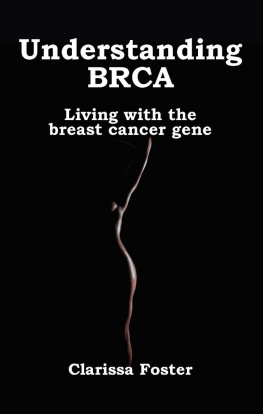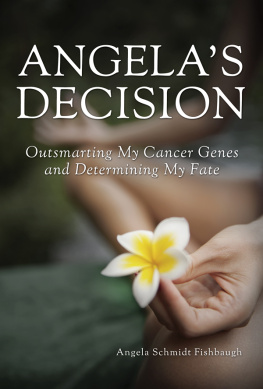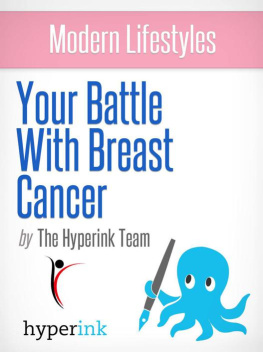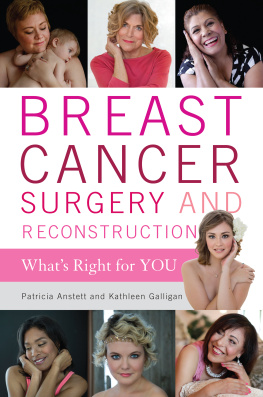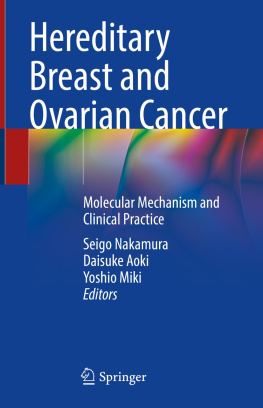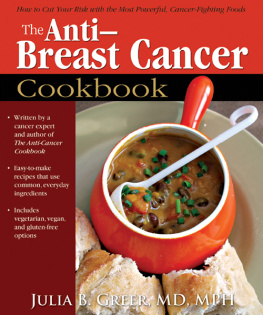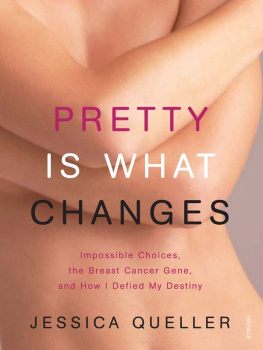James, Isabelle and Ben; I love you so much. You are everything Ive ever wanted and you have given me so much happiness
In this book, Clarissa presents the most thorough overview of a BRCA patients journey. Her story starts years before she realised she might be a BRCA carrier with her own mothers diagnosis of ovarian and covers the decades from her teens to her 30s. She combines the most personal of stories with detailed facts about all manner of issues, including meeting a genetic counsellor, the surgical options available to BRCA carriers which reduce risk and how the various surgeries have affected her physical, social and psychosexual wellbeing. Whether you have just been diagnosed as being a BRCA carrier, know someone affected or suspect you might be considered high risk, this book offers a wealth of information, interspersed with one ladys incredibly brave journey.
Niki Petrie, Consultant Plastic & Reconstructive Surgeon
I remember first meeting Clarissa in a busy clinic one Friday morning. In the short time allocated for her appointment, we discussed a whole myriad of life-changing and irreversible decisions that she faced because of the BRCA are slightly different from other consultations, because the disease has not appeared yet and, indeed, may never do so. Logic and rational thought are needed, but because the science is incomplete, the logic becomes increasingly hazy the deeper you dig. It resembles a half-finished jigsaw puzzle, from which we can only deduce the final picture: and that deduction is personal, because we all see the puzzle in a slightly different light. It is that emotional interaction with the facts that makes us unique. For example: what does a 30% chance of getting a disease actually mean to any one person? To them personally, they either are going to get the disease (100%) or not (0%). Furthermore, how do you correlate the risk reduction with the risks of surgery and a permanently altered body? If there is a 30% chance of something happening and we operate on 100 people, then 30 of those people will have benefited, but 70 will have had the procedure unnecessarily. How does that affect a patients thoughts and emotions? Clarissa has made that journey.
In many respects this book mirrors our consultation. Clarissa has assembled the facts and figures and taken the interpretations and assumptions as far as the incomplete science allows. Incomplete because the science is constantly being advanced and treatments are always changing. Incomplete because we are making lifelong decisions based on fragmented data. Incomplete because the follow-up of previous patients never includes everyone; people move, people forget, other things happen to them. Incomplete, because in the next few years all these decisions could be rendered unnecessary by the advent of a new preventative therapy. But this book tells us how it is today and patients reach a point when they have to make real decisions today, not next year. Time is often a luxury they cannot afford, so they have to put thoughts of the future to one side. Choices have to be made and then acted upon, with all their consequences.
This is what makes this book a must read for anyone facing these choices. They have the knowledge that something may happen to them, often something that patients have witnessed in their loved ones, but crucially may also not happen to them. The risk-reducing treatments that we offer today are significant. The tools of my trade (as a plastic and reconstructive surgeon) are very unforgiving and the risk of complications adds another layer of complexity to already difficult decisions. I am always struck by how brave my patients are prior to surgery and also the importance of support from family and friends. This book is so informative to those who support patients too because Clarissa has given us a summary of the literature as it is today and then shared the emotional journey that she and her loved ones went through.
Although each patients journey is unique, we are all human and anyone carrying a BRCA gene mutation will probably go on a remarkably similar journey. A shared approach to risk reduction involving patients and their doctors is essential. Reading this book places the patient and their family support in an ideal position to achieve that. Bravo, Clarissa.
Mike Tyler, Consultant Plastic & Reconstructive Surgeon
The BRCA mutations are the second most common cancer-causing genes that we can inherit. Identifying people who have these mutations and helping them manage their risk is a hugely important part of keeping people healthy and preventing avoidable cancers.
Clarissa has written a highly accessible and informative book that reflects not just her scientific background but also her experience as someone who has watched a loved one die of a cancer caused by a mutation and as someone who knows they are carrying a gene that can do this to them. She has written this book with the same approach that she used to make her own decisions. She has sought out all the information thats available, not just by reading and researching but also by talking with doctors experienced in looking after people carrying mutations and preventing and treating the cancers they get. Her advisors have included not just those of us who counselled and treated her but others who have generously given time to make sure their areas of expertise are also fully represented.
In this way, Clarissa has achieved the most accurate and comprehensive review of what we know about BRCA mutations currently available anywhere. But whilst it is detailed in its medical content it requires no real background knowledge to understand. It is written for everyone. Clarissa has ordered and analysed the evidence and asked probing questions. She has taken nothing for granted and I know from my many discussions with her that every guideline and research conclusion has been asked to justify itself. In medicine we know that we still have to make decisions even when there is doubt. So it is for women and men carrying these mutations. But she has done more than that. She has opened up and shared her own experiences in intimate detail. And this gives a real human context to the science so that anyone reading this book for help will know that they are not alone. Others have shared the distress and faced the same anxieties but taken control of their destiny and come out the other side stronger and more positive.
I smiled when reading Mike Tylers very nicely observed and honestly expressed Foreword. It resonates with my own discussions with Clarissa and the issues faced by her and, indeed, all the women who have come to me for help. He and I have doubtless discussed many times the issue of what a statistic means to you as an individual. Everyones perception of risk and benefit is unique, even if we mostly draw similar ultimate conclusions. Understanding this is at the very core of ensuring that we help people make sensible decisions that are right for them.
The principles of inheritance and managing risk are simple and it should be easy to get them right. Many women are identified with BRCA mutation at the right time and their risk is managed appropriately. But in reality many women find it hard to get the right advice and to feel secure that they are making the best decision for them. And of course the point is not just to manage the actual risk of getting a cancer but to reduce the anxiety and distress that naturally surrounds being in a family with any cancer-causing mutation. A technical solution without reassurance and context will only go part way to relieving that distress.
The finer details of how to manage that increased risk are more subtle. They include important issues such as whether and, more or preventive risk-reducing surgery and exactly what surgery to have. For this, as well as having a deep knowledge of the facts, doctors need to spend time exploring those concerns with their patients. More than giving advice and information, or even just recommending tests and operations, doctors need to understand their patients hopes, fears and beliefs. Patients need to have faith in their surgeons technical skills of course. But they also need to be confident that their doctors are guiding them in the right direction and understand their worries. Clarissas journey will give healthcare professionals insight into what all our patients go through.

